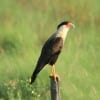 by Jim Stevenson,
by Jim Stevenson,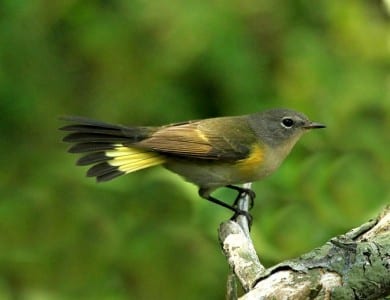
As we slowly creep toward the end of September, the diversity of migrant songbirds increases and a dozen or more warblers a day are easily possible. This is a female American Redstart, showing the feminine yellow patches in the wings and tail. They often catch insects on the wing, and equally often scare bugs off resting places with the flash colors in the wings and tail.
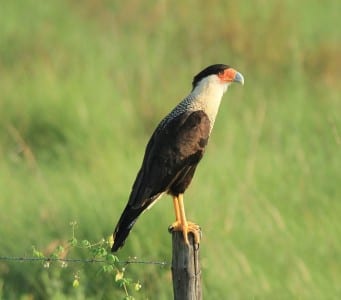
As we slowly creep toward the end of September, the diversity of migrant songbirds increases and a dozen or more warblers a day are easily possible. This is a female American Redstart, showing the feminine yellow patches in the wings and tail. They often catch insects on the wing, and equally often scare bugs off resting places with the flash colors in the wings and tail.
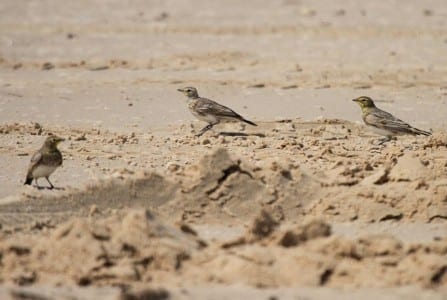
As we slowly creep toward the end of September, the diversity of migrant songbirds increases and a dozen or more warblers a day are easily possible. This is a female American Redstart, showing the feminine yellow patches in the wings and tail. They often catch insects on the wing, and equally often scare bugs off resting places with the flash colors in the wings and tail.
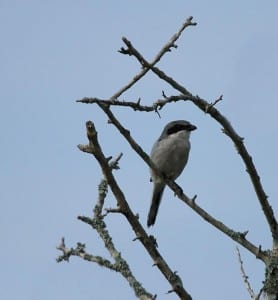
As we slowly creep toward the end of September, the diversity of migrant songbirds increases and a dozen or more warblers a day are easily possible. This is a female American Redstart, showing the feminine yellow patches in the wings and tail. They often catch insects on the wing, and equally often scare bugs off resting places with the flash colors in the wings and tail.
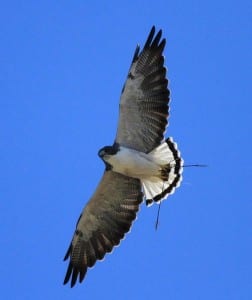
A bit bigger killer is the mighty White-tailed Hawk, with a huge longitudinal range from Texas south to Peru and Argentina. This specimen has a mouse in his talons (see the tail!) as well as a broken stick. The migratory nature ofthis species may be seen in the pointed wings, whilemany less-migratory hawks have far less contrast on their primary lengths.
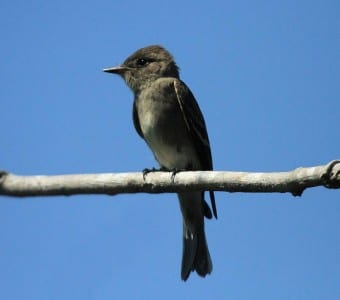
This is not yo’ daddy’s pewee. Note the absence of color and dark flanks; this is the Western Wood-pewee of the Rockies. I get a couple of these a year and this one (the second for this month in 2012) dropped in the 20th. When I first moved here in 1995 it was extremely hard to get records of this species accepted without a specimen but now they are known (mostly from my yard) to occur in very low numbers each year on the UTC.
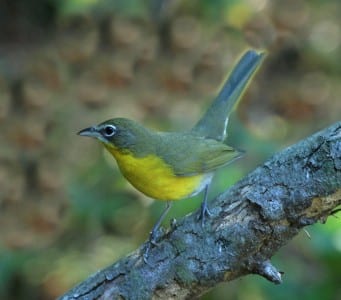
This is the unlikely warbler, the Yellow-breasted Chat, or as my dad called it, a “Yellow¬chested Brat.” Small fruit and larger arthropods are taken by this gargantuan warbler and actual imitations of other songbirds match or exceed mockingbirds in quality. They nest over much of the US and pass through almost undetected by many, due to their hiding and odd calls. I believe they are finally being moved out of warblers.
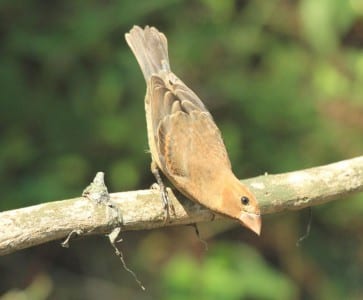
Grosbeaks have enormous bills and the solid colored ones are Blue Grosbeaks. These females are brown with the same hint of wing-bars as the males, one of the chief differences between BGs and Indigo Buntings (which are half their size). This species is famous for its call, a sharp “tink” call, often issued from the tops of bushes and shrubs.
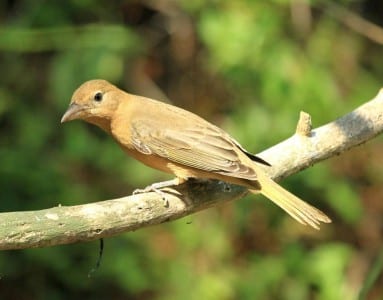
Not too unlike the last species, and both females, is the Summer Tanager. Both the bill and the bird itself are more elongate than the preceding grosbeak with the males often being confused with male cardinals. Whilegrosbeaks (and cardinals) are primarily seed eaters, these tanagers eat a lot of fruit and often, flying insects.
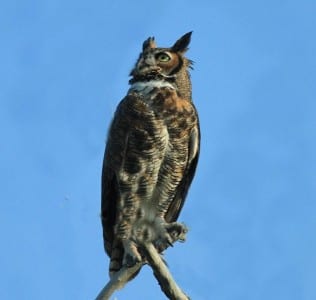
Our yard has become a temporary (?) home for a pair of Great Horned Owls, with this male sometimes sitting out in the open early morning. Here he is watching a kite who’s bombarding him, but the bird seems amazingly tolerant of Liz and me. These eastern birds are quite dark and reddish, more colorful than those of the West. Incidentally, this species occurs from the Pacific to the Atlantic, and from the Arctic to the southern tip of South America. Some range!
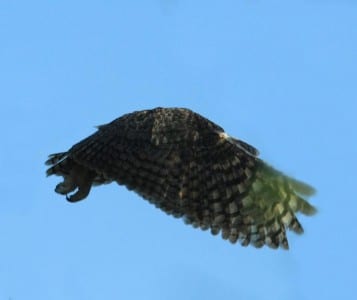
The flight style of a few birds like the GHO demonstrates a wing angle that’s more forward than up and down. This effectively hides the head and cuts down on glare generated by the bright sunlight. All owls fly silently as their flight feathers have soft edges, a wonderful adaptation in nocturnal flight.
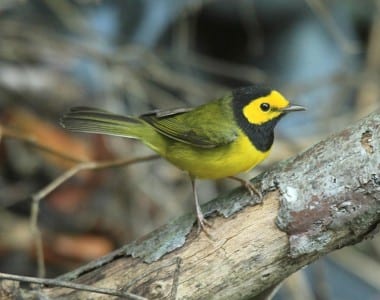
A beautiful species of deep woods bird is the Hooded Warbler. This male sports the helmet of its species and a deep, liquid chip he shares with the gals. A decidedly eastern bird, Hoodeds live in moist woodlands and are heard more often than seen. A number of yellow warblers have various black markings on the head, while the species “Yellow Warbler” has none.
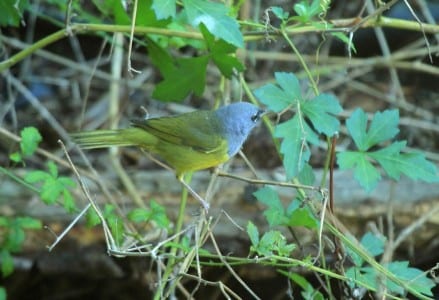
One of our rarest warblers is theMacGillivray’s Warbler, a member of agroup having gray heads. These have partial white eyerings like the (slightly) more common Mourning but the white is restricted to an upper and lower line. MacGillivray’s are quite common out West where they replace Morning and Connecticut, but notthe superficially-similar Nashville (common as all get-out). This is my third MacGillivray’s Warbler in 17 years here, so it’s a pretty rare bird.
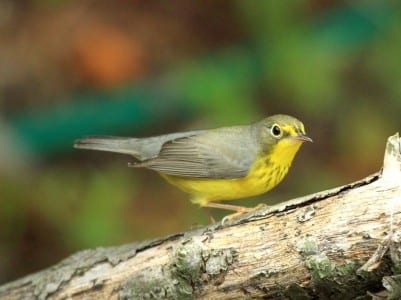
One species that’s fairly common in the deep woods from late August to late September, but scarce the rest of theyear is the Canada Warbler. This female has the characteristic weak necklace of its sex, the dark top and prominent eyering of all Canadas. They are sometimes overlooked as deep woods birds but heavy forests like Laffite’s Cove (on Galveston) often have them seasonally.
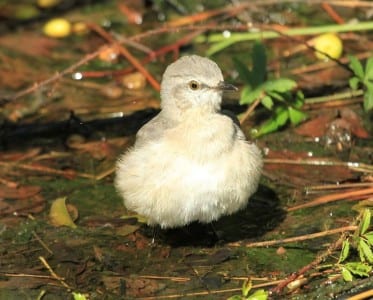
Mockingbirds and a few others enter shallow ponds and puff out their feathers to bathe more effectively. This adult looked like it could hardly fly when it came time to go but quickly shed its water. Bathing is especially importantto migratory birds as they come in contact with all kinds of unknown plants and hidden animals, often with few real protections against them.
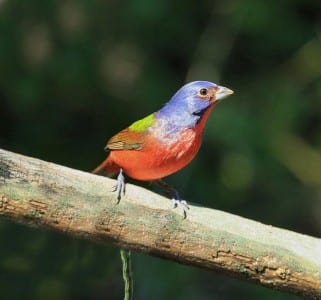
Most Painted Buntings are early fall migrants, with a relative few passing through this late. This fine male really had to pee (see?), OK, it’s my drip. But after the amount he drank, I’m sure that happened later. Birds prefer spigot water to ponds and such, and much of the standing water on Galveston Island is fairly salty anyway. I suspect a bird passing through this late is probably from North Texas or possibly Oklahoma.
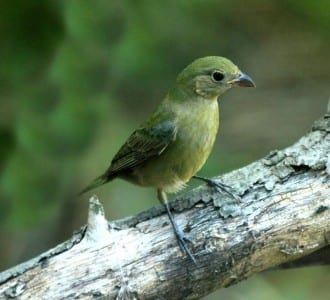
What female and immature Painted Buntings lack in color they make up for in amazing camouflage. This is a young bird – perhaps one of ours – as you can see the yellow skin at the base of the bill. Buntings are basically colorful sparrows with many having wide ranges and being familiar to many. Some buntings we got from our Tropics and others came across from the Old World via Alaska (historically).
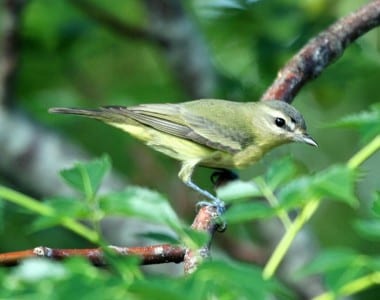
Two very similar vireos pass through in low numbers in fall, with these Philadelphia Vireos arriving in late September and October. They are a little greener than Warbling and have more of a marked face. Note the vireo bill, cylindrical and hooked. Vireos eat a lot of caterpillars and the hook helps thempull the larval insects out of crevices.

Two very similar vireos pass through in low numbers in fall, with these Philadelphia Vireos arriving in late September and October. They are a little greener than Warbling and have more of a marked face. Note the vireo bill, cylindrical and hooked. Vireos eat a lot of caterpillars and the hook helps thempull the larval insects out of crevices.
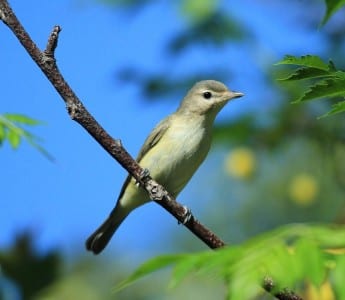
Warbling Vireos are grayer than Philly with very little facial markings. They are a basic gray, though with a bit more color than some of the western vireos. Again, note the vireo bill, and you can also see rictal bristles emanating from the bill base. Warbling arrive in late August and are found throughout September, B4 giving way to Phillies in October.
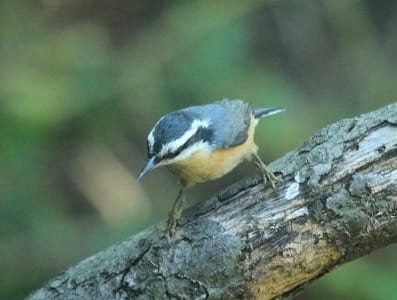
Only my second yard record of the Red-breasted Nuthatch, this bird appeared very early for the species, on September 20. Common over much of the continent, their yank yank notes may be confused with White-breasted, but neither really appears in the Great Plains arena much. There are claims of resident Brown-headed Nuthatches in Laffite’s Cove on Galveston historically, but I have my doubts.
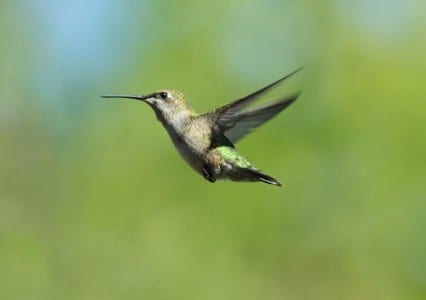
Virtually every hummer seen east of the Great Plains is a Ruby-throated, although a few odd species slip by from the West. This female RT shows off her glittering green and shortish bill, both typical of our common species. I see very, very few male RTs by this time in September, although a few slip through.
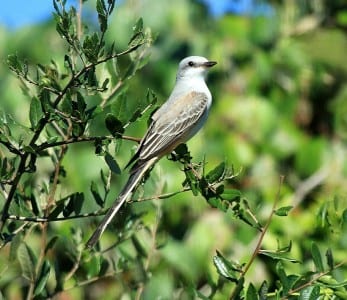
Scissor-tailed Flycatchers have a rather unique range, breeding mostly in a circle that encompasses the plains of North Texas and Oklahoma. In mid-fall they migrate south in massive numbers, especially through areas like San Antonio. Their tails continue to grow until they reach their wintering grounds, whereupon they molt and start growing their tails once again. This was the third year they nested on my property.
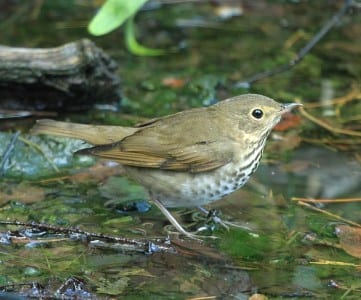
Scissor-tailed Flycatchers have a rather unique range, breeding mostly in a circle that encompasses the plains of North Texas and Oklahoma. In mid-fall they migrate south in massive numbers, especially through areas like San Antonio. Their tails continue to grow until they reach their wintering grounds, whereupon they molt and start growing their tails once again. This was the third year they nested on my property.

 Posted in
Posted in 


























I enjoy your feathered friends reports– however- your photo showing a songbird is actually the raftor Cara Cara (Mexican eagle) and isn’t a migratory bird here anymore- i’ve seen them year round here now for over 4 years- Being from south Texas i’m used to seeing them down around the Harlingen and Choke Canyon areas but was really surprised to see them up here in our beach area- Thank You for your articles and photos– ed snyder